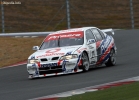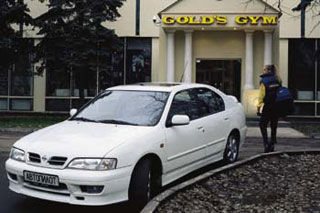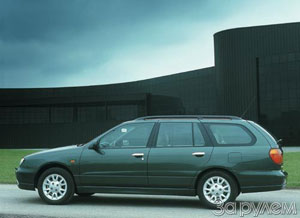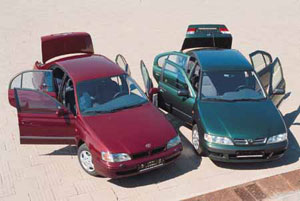Test drive Nissan Primera sedan 1996 - 1999 sedan
Small change
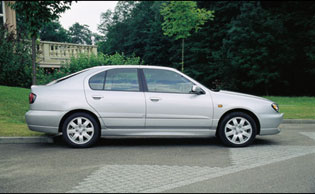 The wife divides cars into boys and girls. I used to laugh at this, but agreed with such a life position when I saw Nissan Primera 2000.
The wife divides cars into boys and girls. I used to laugh at this, but agreed with such a life position when I saw Nissan Primera 2000. The previous version of the Nissan Primera belongs to a strong half. Beautiful, reliable, but deprived of the main thing that we value in women, charm. It is impossible to get attached to her. So that for years. She is a faithful friend and partner, but no more. It does not pull it even after long separation. Another thing is Primera 2000.
MAKEUP. Although no, this is not a tightening or rude makeup. Oh, good! The first reaction to her appearance of friends-male colleague. A normal male will never respond to the old lady, pulling the old skin in the calculation of success. This is just a complete change of image that guarantees one hundred percent success.
The curious coincidence of the outwardly Nissan Primera 2000 resembles Renault Laguna. But the unification of the two firms was not announced so long ago, and it is quite obvious that the design developments of the new appearance of Primera ended long before that. We will consider this a simple coincidence
So, first of all, the front of the car has changed. A beak appeared on the hood cover, into which the radiator grille is integrated. The form of headlights has fundamentally changed. You can’t say about them that this is so fashionable in modern design to the Eastern squint is rather a successful cosmetic operation to Europeanizing this squint. And it is not surprising all the work on creating a new Primera was carried out in Europe, and this model is designed exclusively for Europe.
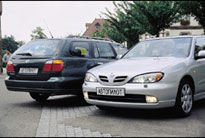 Of the autopilot’s bodies offered to our attention, the hatchback liked the most stylish protrusion a la Anti-Wing on the fifth door most of all. The sedan seemed too boring and traditional, despite the rear lights of a fundamentally new shape, and the station wagon is too heavy. By the way, in this case, the form corresponds to the content of all Primera Wagon options was the least prominent.
Of the autopilot’s bodies offered to our attention, the hatchback liked the most stylish protrusion a la Anti-Wing on the fifth door most of all. The sedan seemed too boring and traditional, despite the rear lights of a fundamentally new shape, and the station wagon is too heavy. By the way, in this case, the form corresponds to the content of all Primera Wagon options was the least prominent. SALON. He was subjected to fundamental changes designed to create a maximum of convenience and comfort with a minimum of costs. Still, we have not a luxury luxury, but a middle-class sedan. The price of such a machine cannot exceed a certain limit. Nevertheless, in the Wagon version, we found both leather seats and wood finishes. Although the sporting option in Primera is a hatchback will look at a more stylish black plastic, aluminum inserts and white sports dials of devices.
The main place on the central panel is occupied by an audio system with the ability to control the CD changer located in the trunk. And with an unusual function in radio tape recorders of this class, an automatic recording of the last four information about traffic jams. Under it there is already a very serious climatic installation of two miniature displays show the temperature and mode of operation of the fan. Between them is a mechanical regulator of the air flow. It looks a little unusual, but quite justified for a car of this class.
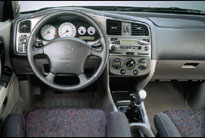 Female logic. Journalists were offered to get acquainted with three options for a sedan with a new engine of 1.8 liters and a mechanical gearbox, a station wagon and a hatchback with a 2.0 liter engine and a sequential automatic variator -type gearbox.
Female logic. Journalists were offered to get acquainted with three options for a sedan with a new engine of 1.8 liters and a mechanical gearbox, a station wagon and a hatchback with a 2.0 liter engine and a sequential automatic variator -type gearbox. An interesting behavior of the variator in comparison with a normal automatic box is manifested with a sharp pressing and holding the gas pedal. At first, the speeds of about 55006000 are sharply increased. The speed increases slowly. Then the process occurs accurately, on the contrary, the tachometer shooter freezes like glued, but the speedometer arrow begins to fall to the right steadily. This is especially pronounced on the highway, when there is a desire to sharply spur, for example, from 70 to 140 km/h and above. The feeling is that the machine takes a timeout before you completely surrender to the owner. Well, what is not a female character?
And with a sharp start from a place in Kick Down mode, to a speed threshold of 5060 km/h, the variator behaves similarly to an automatic box, only the transmission process occurs more smoothly, without shocks.
Transfigurations are placed in quotation marks for a reason. They simply do not exist. The rigid combination of gears, corresponding in other boxes to a certain transfer number, replaces the belt transmission with a variable diameter of the guide drums in the variator. The smaller the diameter, the higher the speed of the car.
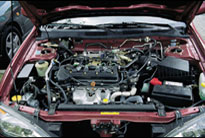 The first ball. Until now, variators have been installed mainly on motorcycles, scooters and small -class cars of the Nissan Micra type. In the case of Primera, Nissan went, in our opinion, to a certain risk, offering a similar transmission in the sector S. Pravda, this variator is not as simple as it seems at first glance. It provides for a transition to a manual mode, and this is perhaps the first attempt in the world to combine mechanics and a machine gun on a variator. It should be noted that quite successful. In manual mode, Primera behavior is almost completely adequate to the reactions of a car with a mechanical box to all the actions of the driver. This is especially clearly manifested when switching to lower gear. It was not without reason that for a test drive we were offered mountain roads, on which more often usual we have to use braking with an engine and sharp accelerations for overtaking.
The first ball. Until now, variators have been installed mainly on motorcycles, scooters and small -class cars of the Nissan Micra type. In the case of Primera, Nissan went, in our opinion, to a certain risk, offering a similar transmission in the sector S. Pravda, this variator is not as simple as it seems at first glance. It provides for a transition to a manual mode, and this is perhaps the first attempt in the world to combine mechanics and a machine gun on a variator. It should be noted that quite successful. In manual mode, Primera behavior is almost completely adequate to the reactions of a car with a mechanical box to all the actions of the driver. This is especially clearly manifested when switching to lower gear. It was not without reason that for a test drive we were offered mountain roads, on which more often usual we have to use braking with an engine and sharp accelerations for overtaking. On the Horner serpentine of Alsace and German highways, the new Primera has proven itself perfectly. With any body and any box. After a couple of months, at the International Motor Show in Frankfurt, a presentation of the new Primera will take place before the general public, after which official sales will begin. Unfortunately, the price has not yet been officially set. It will definitely be slightly higher than the previous model.
Text Nikolay Kachurin, photo of the author and Nissan
Source: "Autopilot"
Video Crash tests Nissan Primera Sedan 1996 - 1999
Test drives Nissan Primera Sedan 1996 - 1999
Crash Test Nissan Primera Sedan 1996 - 1999
Krassh Test: Detailed Information19%
Driver and passengers
10%
Pedestrians



